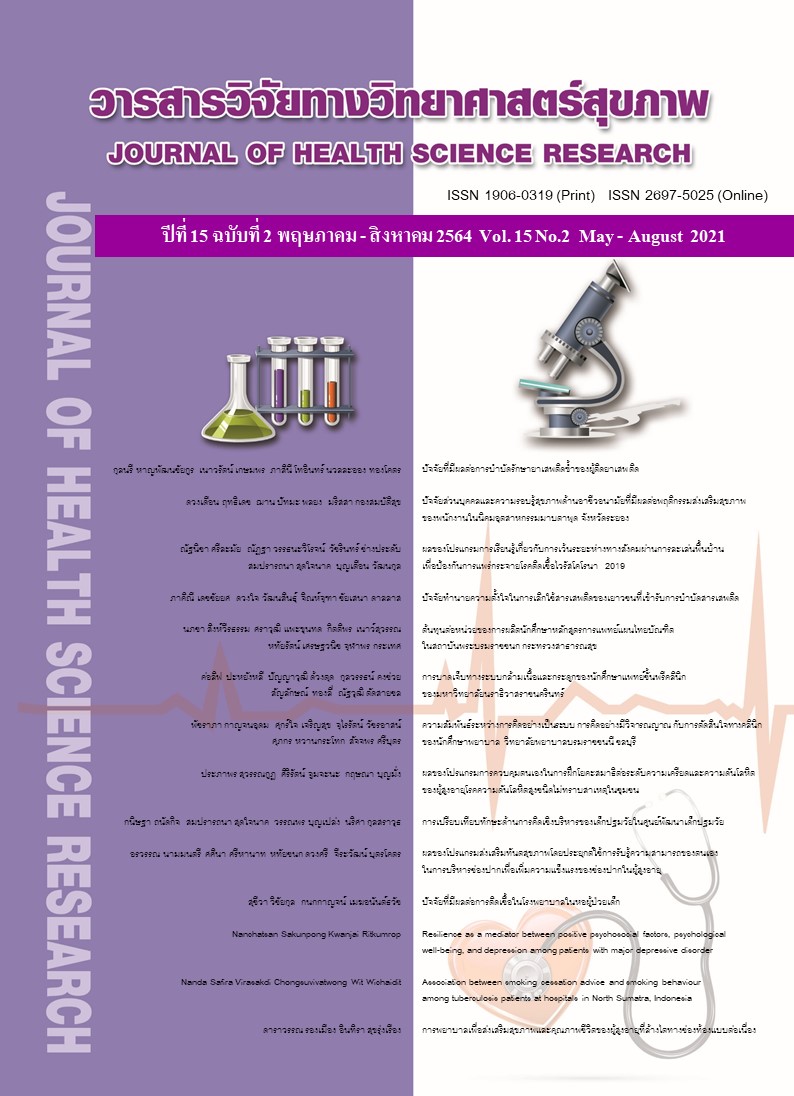ความสัมพันธ์ระหว่างการให้คำแนะนำด้านการเลิกบุหรี่และพฤติกรรมการสูบบุหรี่ ในกลุ่มผู้ป่วยวัณโรคที่โรงพยาบาลในจังหวัดสุมาตราเหนือ ประเทศอินโดนีเซีย
Main Article Content
บทคัดย่อ
บทนำ : ปัจจุบันมีคำแนะนำให้บุคลากรสาธารณสุขแนะนำให้ผู้ป่วยวัณโรคเลิกบุหรี่ตามแนวทาง ABC (ask, brief advice, cessation support) ซึ่งผู้สังเกตการรักษาวัณโรค (ผู้ทำ DOTS) อาจมีบทบาทสำคัญในการส่งเสริมการเลิกบุหรี่ แต่ยังมีข้อมูลค่อนข้างน้อยในเรื่องความสัมพันธ์ระหว่างมาตรการดังกล่าวกับการเลิกบุหรี่
วัตถุประสงค์การวิจัย : เพื่อประเมินความสัมพันธ์ระหว่างการให้คำแนะนำการเลิกบุหรี่กับความเปลี่ยนแปลงของพฤติกรรมการสูบบุหรี่ในกลุ่มผู้ป่วยวัณโรคในประเทศอินโดนีเซียที่มีพฤติกรรมสูบบุหรี่เมื่อได้รับการวินิจฉัยวัณโรค
วิธีการวิจัย : เป็นการวิจัยเชิงพรรณนาแบบภาคตัดขวาง ตัวอย่างคือ ผู้ป่วยวัณโรคปอดที่มีประวัติสูบบุหรี่ ณ วันที่วินิจฉัยวัณโรค จำนวน 38 คน คัดออก 4 คน (ตัวอย่าง = 34 คน) จัดตัวอย่างเป็น 2 กลุ่ม ได้แก่ กลุ่มผู้เลิกบุหรี่ และกลุ่มผู้ยังคงสูบบุหรี่ วิเคราะห์ข้อมูลโดยใช้สถิติเชิงพรรณนา และวิเคราะห์การถดถอยแบบหลายตัวแปร
ผลการวิจัย : ผู้ป่วย 11 คน จาก 34 คน (ร้อยละ 32.40) ที่ได้รับคำแนะนำตามแนวทาง ABC โดยครบถ้วน มีโอกาสเลิกบุหรี่น้อยกว่าผู้ป่วยที่ได้รับแนวทาง ABC ไม่ครบถ้วน (13.3% vs. 47.4%, ตามลำดับ; Adjusted OR = 0.12; 95%CI = 0.01 - 1.24) ส่วนการได้รับคำแนะนำการเลิกบุหรี่จากผู้ทำ DOTS มีความสัมพันธ์เชิงบวกกับการเลิกบุหรี่ (Adjusted OR = 4.77; 95%CI = 0.65 - 34.81)
สรุปผล : การได้รับแนวทาง ABC มีความสัมพันธ์เชิงลบกับการเลิกบุหรี่ ส่วนการได้รับคำแนะนำจากผู้ทำ DOTS อาจมีอิทธิพลต่อการเลิกบุหรี่ อย่างไรก็ดี การวิจัยนี้มีอำนาจทางสถิติต่ำและอาจมีการให้คำตอบที่พึงปรารถนาทางสังคม การนำไปใช้ควรใช้วิจารณญาณในการตีความผลการวิจัย
Downloads
Article Details
บทความที่ได้รับการตีพิมพ์เป็นลิขสิทธิ์ของวิทยาลัยพยาบาลบรมราชชนนี จังหวัดนนทบุรี
ข้อความที่ปรากฏในบทความแต่ละเรื่องในวารสารวิชาการเล่มนี้เป็นความคิดเห็นส่วนตัวของผู้เขียนแต่ละท่านไม่เกี่ยวข้องกับวิทยาลัยพยาบาลบรมราชชนนี จังหวัดนนทบุรี และคณาจารย์ท่านอื่น ในวิทยาลัยฯ แต่อย่างใด ความรับผิดชอบองค์ประกอบทั้งหมดของบทความแต่ละเรื่องเป็นของผู้เขียนแต่ละท่าน หากมีความผิดพลาดใด ๆ ผู้เขียนแต่ละท่านจะรับผิดชอบบทความของตนเองแต่ผู้เดียว
เอกสารอ้างอิง
Balian DR, Davtyan K, Balian A, Grigoryan A, Hayrapetyan A, Davtyan H. Tuberculosis treatment and Smoking, Armenia, 2014–2016. J Clin Tuberc Other Mycobact Dis. 2017;8:1–5. doi: 10.1016/ j.jctube.2017.04.001.
Wang M-G, Huang W-W, Wang Y, Zhang Y-X, Zhang M-M, Wu S-Q, et al. Association between tobacco smoking and drug-resistant tuberculosis. Infect Drug Resist. 2018;12(11):873–87. doi: 10.2147/IDR.S164596.
Bissell K, Fraser T, Chiang C-Y, Enarson DA. Smoking cessation and smokefree environments for tuberculosis patients. Paris, France: International Union Against Tuberculosis and Lung Disease; 2010. [Internet]. 2010 [cited 2021 May 7] Available
from: https://theunion.org/sites/default/file.
World Health Organization. Global Tuberculosis Report 2019. Geneva: World Health Organization; 2019. [Internet]. 2019 [cited 2020 Aug 10] Available from: https://apps.who.int/iris/ bitstream/handle/.
World Health Organization. WHO Report on the Global Tobacco Epidemic, 2019: Country profile Indonesia [Internet]. 2019. [cited 2021 May 7] Available from: https://www.who.int/tobacco/surveillance/ policy/country_profile/idn.pdf.
Kusumawardani N, Tarigan I, Suparmi, Schlotheuber A. Socio-economic, demographic and geographic correlates of cigarette smoking among Indonesian adolescents: results from the 2013 Indonesian Basic Health Research (RISKESDAS) survey. Glob Health Action. 2018;11(sup1):146760 5. doi: 10.1080/16549716.2018. 1467605.
Global Adult Tobacco Survey Collaborative Group. Global Adult Tobacco Survey (GATS): Core Questionnaire with Optional Questions, Version 2.0. Atlanta, GA: Centers for Disease Control and Prevention; 2010. [Internet]. 2010 [cited 2020 Mar 6] Available from: https://www.who.int/tobacco/surveillance.
Fagerström K, Furberg H. A comparison of the Fagerström Test for nicotine dependence and smoking prevalence across countries. Addiction. 2008;103(5): 841–5. doi: 10.1111/j.1360-0443.2008.02190.x.
Heatherton TF, Kozlowski LT, Frecker RC, Fagerström KO. The Fagerström test for nicotine dependence: a revision of the Fagerström tolerance questionnaire. Br J Addict. 1991;86(9):1119–27. doi: 10.1111 /j.1360-0443.1991.tb01879.x.
Bam TS, Aditama TY, Chiang CY, Rubaeah R, Suhaemi A. Smoking cessation and smokefree environments for tuberculosis patients in Indonesia-a cohort study. BMC Public Health. 2015; 2;15(1):604. doi: 10.1186/s12889-015-1972-2.
Chongsuvivatwong V. Analysis of epidemiological data using R and Epicalc.
Songkhla: Epidemiology Unit, Prince of Songkla University; 2015. (in Thai).
Dogar O, Elsey H, Khanal S, Siddiqi K. Challenges of integrating tobacco cessation interventions in TB Programmes: Case studies from Nepal and Pakistan. J Smok Cessat. 2016;11(2):108–15. doi: 10.1017/jsc.2015.20.
Campbell IA, Chaudhary RD, Holdsworth GM, Lyne OD. Brief advice to tuberculosis patients in Nepal to stop smoking: a pilot study by the Britain Nepal Medical Trust. Int J Tuberc Lung Dis. 2014;18(12):1438–42. doi: 10.5588/ijtld.14.0358.
Nichter M, Padmawati S, Ng N. Introducing smoking cessation to Indonesian males treated for tuberculosis:
The challenges of low-moderate level smoking. Soc Sci Med. 2016;152:70–9. doi: 10.1016/j.socscimed.2016.01.028.


